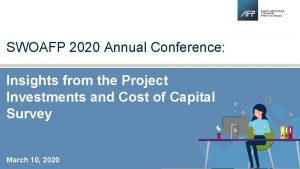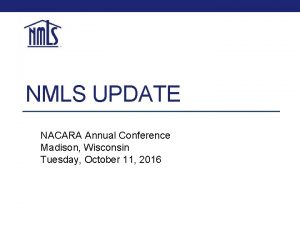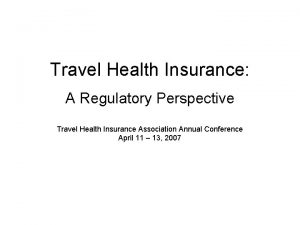2013 EGPA ANNUAL CONFERENCE STRATEGIC MANAGEMENT IN GOVERNMENT













- Slides: 13

2013 EGPA ANNUAL CONFERENCE STRATEGIC MANAGEMENT IN GOVERNMENT PERMANENT STUDY GROUP XI THE DEVELOPMENT OF THE STRATEGIC STATE: Central management and intervention in locally delivered public services in England 1997 -2013 Pete Murphy Nottingham Business School September 2013

Introduction (and some contextual background) � Historically – Inspection services early 19 th Century - education provision (Factory Acts 1833) Police in 1856 with HMIC � Post Second World War – plethora of new inspectorates e. g. Social Services Inspectorate. � Key modern milestones were the Audit Commissions’ establishment in 1983, and Best Value and continuous improvement being introduced in 1999 LG Act � This paper is concerned with the state (through inspectorates) overseeing the performance measurement, management and monitoring of locally delivered public services to local populations by local authorities and other locally based agencies. � It also shows how creating public value and public service innovation became evident in the performance management regimes and legislation after 2002

1997 – 2010 Labour Administrations A case for the development of the Strategic State? � The objectives, management and monitoring arrangements for the delivery of public services became more integrated across central and local government. � Local service delivery demonstrably improved, while the policy, support, guidance and monitoring by central government became both more effective and strategic. � This paper reviews the development of successive performance management regimes and in particular the most sensitive part of these regimes i. e. how they dealt with the significantly underperforming services and organisations. � It also looks at the states development of strategic collaborations and partnerships (although operational partnerships were also multiplying) � This period provides a clear case study of the development of a coherent and strategic approach from the central state in this particular area of government activity, gradually supported by all key stakeholders.

2010 – 2013 Coalition Government Political Expediency or is the Strategic state reemerging? � The initially post election period was characterised by theoretical and practical confusion which generated a very fragmented approach dominated by the fiscal cuts. � More recently the public service has seen the re-emergence of a more strategic approach in circumstances where the coalition government has engaged in consultation and discourse with the public and key stakeholders � It is not clear whether the latter is the result of political pressure or expediency – or part of the realisation of the potential of the Strategic State

1997 -2010 How did the state get more strategic? Two fields - performance management regimes and creating strategic collaborations and networks � � Performance Management Regimes where assessing and assuring increasingly joined up policy and delivery for continuous improvement in public services. The regimes were continually becoming better integrated and mutually supporting across the various parts of the public sector. � Central and Local government acted as a proactive ‘entrepreneurial’ state – taking risks, and creating a highly networked policy and delivery system � State also acted as lead investor and catalyst for both improvement and innovation – not simply as safety net for failure. Theoretically or Conceptually

The strategic state Improving Performance Management Regimes � � � � Creating and Improving Networks Partnerships and Agreements Best Value Comprehensive Performance Assessments Standards for Better Health Police assessments CPA 2 The Harder Test World Class Commissioning Comprehensive Area Assessments � � � Practically Comprehensive Spending Reviews and Public Service Agreements (1997 -2010) Local Public Service Agreements (Rounds 1 and 2) Local Area Agreements – pilots 2004/05 – rolled out across country by March 2007 2 nd round 2007/08 – 2010/11 2009 - Multiple Area Agreements and Total Place

The demonstrable evidence or proof of the state becoming strategic and more holistic Improvement Assessment and Intervention Regimes � � From Service Assessments to Corporate Assessments to Area Assessments. Tools techniques and agents converged as they individually and collectively learnt from their collective and increasingly shared experiences. Improvement and Intervention Infrastructure � � The evidence bases developed from data poor to data rich to intelligent data Post 2005 (in particular) the infrastructure became more economic, efficient and effective with increasing returns on investment. What about outputs and outcomes? � � Each version of PSAs/LAA/MAA became more strategic in terms of scope, content and objectives. Each version or generation of PSAs/LAAs/MAAs and the Performance Assessment Regimes required less resources to establish, operationalize and maintain.

Some indicative watchwords and catchphrases � In the performance management regimes ’beyond compliance’ and ‘continuous improvement’ to innovation and creativity � Jim Collin’s ‘Good to great’ became from ‘excellence to exemplary’ � In the Intervention team - We will support improvement - we will not reward failure

Post 2010 Coalition Government Performance Assessment Regimes � Reducing public expenditure not improving public services has become the focal objective � Causing collateral damage as key parts of the improvement infrastructure (including independent agencies such as AC) have been abolished in the ‘bonfire of the QUANGOs’ � Central Government confusion in retention of CSRs but not PSAs. � Local Government – localism and sector lead improvement and intervention. � Health – Performance regime strengthened (although the 2012 Health and Social Care Act was a governmental and administrative debacle). � Police – HMIC retained but now Police and Crime Commissioners and Policing Panels replace Police Authorities � Fire and Rescue – New National Framework and Commissioning model introduced

Post 2010 Coalition Government’s differing approaches to Intervention � Local Government – Intervention by LGA and local government peers rather than central government � Health – CQC and MONITOR regimes have been strengthened, and government has been more disposed to using them � Police – HMIC lead system retained but PCC imposed with little public support � Fire and Rescue – old system reaffirmed despite it being demonstrably inferior to later models

Post 2010 Coalition Governments Collaboration and Partnership The example of Public Health and Wellbeing Boards under the 2012 Health and Social Care Act

Post 2010 Coalition Government Short term fragmentation/ Long term re-emergence of the strategic state? Short Term Long Term � Fiscal reduction as the overriding policy towards public services � Optimizing useful production in public, private and third sectors � Policy based evidence making � Evidence based policy making � Abolition and dismantling of improvement infrastructure � Promoting and developing systemic and organisational innovation and improvement � Jeffersonian/Thatcherite state rhetoric – government that governs least governs best � Re-emergence of the strategic and entrepreneurial state

Questions? Contact details: Pete Murphy Nottingham Business School Nottingham Trent University Newton Building, Burton Street, Nottingham NG 1 4 BU. Peter. murphy@ntu. ac. uk Tel 0 (+44) 115 848 8092 Mob 0 (+44) 77758 77949
 Afp annual conference 2020
Afp annual conference 2020 Od network
Od network Nacada annual conference
Nacada annual conference Hepi conference
Hepi conference Nmls conference
Nmls conference Gie annual conference
Gie annual conference Fuze conference 2018
Fuze conference 2018 Annual conference on pbfeam
Annual conference on pbfeam Travel health insurance association annual conference
Travel health insurance association annual conference Gcyf 2011 annual conference
Gcyf 2011 annual conference 2017 dvhimss annual fall conference
2017 dvhimss annual fall conference Iowa league of cities annual conference
Iowa league of cities annual conference Stfm annual spring conference
Stfm annual spring conference Stfm conference
Stfm conference

























